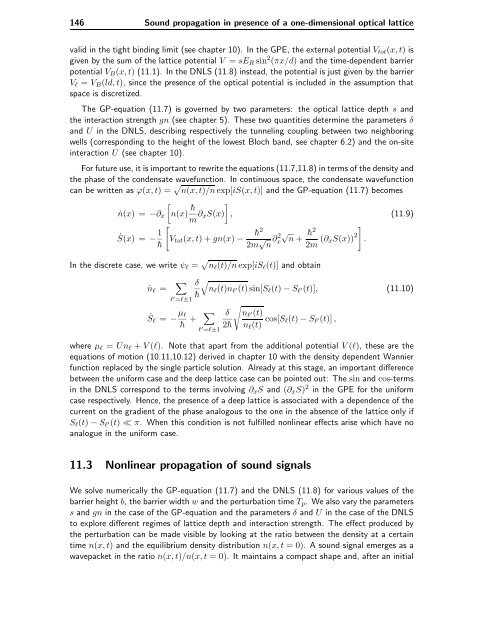Bose-Einstein Condensates in Rotating Traps and Optical ... - BEC
Bose-Einstein Condensates in Rotating Traps and Optical ... - BEC
Bose-Einstein Condensates in Rotating Traps and Optical ... - BEC
Create successful ePaper yourself
Turn your PDF publications into a flip-book with our unique Google optimized e-Paper software.
146 Sound propagation <strong>in</strong> presence of a one-dimensional optical lattice<br />
valid <strong>in</strong> the tight b<strong>in</strong>d<strong>in</strong>g limit (see chapter 10). In the GPE, the external potential Vtot(x, t) is<br />
givenbythesumofthelatticepotentialV = sER s<strong>in</strong>2 (πx/d) <strong>and</strong> the time-dependent barrier<br />
potential VB(x, t) (11.1). In the DNLS (11.8) <strong>in</strong>stead, the potential is just given by the barrier<br />
Vℓ = VB(ld, t), s<strong>in</strong>ce the presence of the optical potential is <strong>in</strong>cluded <strong>in</strong> the assumption that<br />
space is discretized.<br />
The GP-equation (11.7) is governed by two parameters: the optical lattice depth s <strong>and</strong><br />
the <strong>in</strong>teraction strength gn (see chapter 5). These two quantities determ<strong>in</strong>e the parameters δ<br />
<strong>and</strong> U <strong>in</strong> the DNLS, describ<strong>in</strong>g respectively the tunnel<strong>in</strong>g coupl<strong>in</strong>g between two neighbor<strong>in</strong>g<br />
wells (correspond<strong>in</strong>g to the height of the lowest Bloch b<strong>and</strong>, see chapter 6.2) <strong>and</strong> the on-site<br />
<strong>in</strong>teraction U (see chapter 10).<br />
For future use, it is important to rewrite the equations (11.7,11.8) <strong>in</strong> terms of the density <strong>and</strong><br />
the phase of the condensate wavefunction. In cont<strong>in</strong>uous space, the condensate wavefunction<br />
can be written as ϕ(x, t) = n(x, t)/n exp[iS(x, t)] <strong>and</strong> the GP-equation (11.7) becomes<br />
<br />
˙n(x) =−∂x n(x) ¯h<br />
m ∂xS(x)<br />
<br />
, (11.9)<br />
˙S(x) =− 1<br />
<br />
Vtot(x, t)+gn(x) −<br />
¯h<br />
¯h2<br />
2m √ n ∂2 √ ¯h<br />
x n + 2<br />
<br />
2<br />
(∂xS(x)) .<br />
2m<br />
In the discrete case, we write ψℓ = nℓ(t)/n exp[iSℓ(t)] <strong>and</strong> obta<strong>in</strong><br />
˙nℓ = <br />
ℓ ′ δ<br />
<br />
nℓ(t)nℓ<br />
¯h<br />
=ℓ±1<br />
′(t)s<strong>in</strong>[Sℓ(t) − Sℓ ′(t)], (11.10)<br />
˙Sℓ = − µℓ<br />
<br />
δ nℓ<br />
+<br />
¯h 2¯h<br />
′(t)<br />
nℓ(t) cos[Sℓ(t) − Sℓ ′(t)] ,<br />
ℓ ′ =ℓ±1<br />
where µℓ = Unℓ + V (ℓ). Note that apart from the additional potential V (ℓ), these are the<br />
equations of motion (10.11,10.12) derived <strong>in</strong> chapter 10 with the density dependent Wannier<br />
function replaced by the s<strong>in</strong>gle particle solution. Already at this stage, an important difference<br />
between the uniform case <strong>and</strong> the deep lattice case can be po<strong>in</strong>ted out: The s<strong>in</strong> <strong>and</strong> cos-terms<br />
<strong>in</strong> the DNLS correspond to the terms <strong>in</strong>volv<strong>in</strong>g ∂xS <strong>and</strong> (∂xS) 2 <strong>in</strong> the GPE for the uniform<br />
case respectively. Hence, the presence of a deep lattice is associated with a dependence of the<br />
current on the gradient of the phase analogous to the one <strong>in</strong> the absence of the lattice only if<br />
Sℓ(t) − Sℓ ′(t) ≪ π. When this condition is not fulfilled nonl<strong>in</strong>ear effects arise which have no<br />
analogue <strong>in</strong> the uniform case.<br />
11.3 Nonl<strong>in</strong>ear propagation of sound signals<br />
We solve numerically the GP-equation (11.7) <strong>and</strong> the DNLS (11.8) for various values of the<br />
barrier height b, the barrier width w <strong>and</strong> the perturbation time Tp. We also vary the parameters<br />
s <strong>and</strong> gn <strong>in</strong> the case of the GP-equation <strong>and</strong> the parameters δ <strong>and</strong> U <strong>in</strong> the case of the DNLS<br />
to explore different regimes of lattice depth <strong>and</strong> <strong>in</strong>teraction strength. The effect produced by<br />
the perturbation can be made visible by look<strong>in</strong>g at the ratio between the density at a certa<strong>in</strong><br />
time n(x, t) <strong>and</strong> the equilibrium density distribution n(x, t =0). A sound signal emerges as a<br />
wavepacket <strong>in</strong> the ratio n(x, t)/n(x, t =0). It ma<strong>in</strong>ta<strong>in</strong>s a compact shape <strong>and</strong>, after an <strong>in</strong>itial




